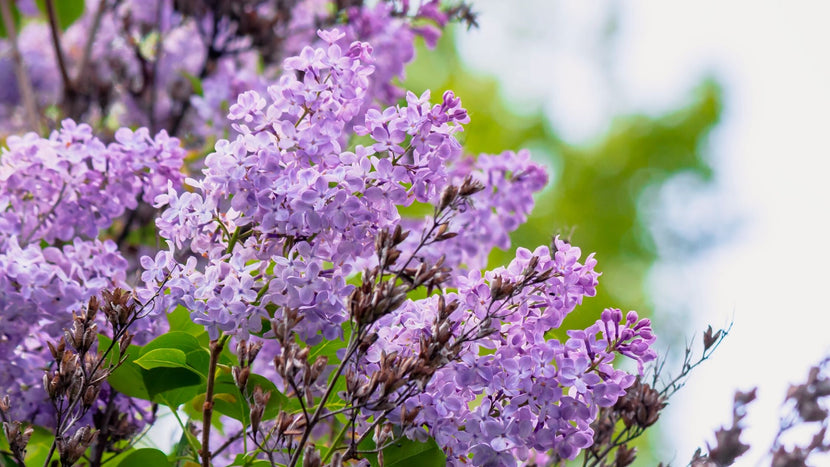How To Plant a Lilac Shrub
Plant Guide

Lilac flowers are stunning additions to a landscape, have a recognizable and intoxicating aroma, and work to support local ecosystems! A single bush can bring a fresh scent to any area of the garden. When planted in bulk as a hedge or foundation shrub, that aroma is magnified!
Lilac flowers burst forth in the mid to late spring, and our newer varieties continue to re-bloom through the early to mid-summer so you can enjoy the delicious fragrance for longer. The delicate blossoms and greenery can also be trimmed and placed in a vase so you can enjoy their beauty and aroma from indoors as well!
With a wide range of Lilac varieties to choose from, you can easily choose the shrub that best fits your yard's style and aesthetic. It is important to note that each variety has its own set of care and maintenance requirements, however, there are certain rules that can be applied to all. Learn more about those below!
Ground Rules
Light
Lilac shrubs typically do best in areas that receive full sun.
Water
Once your Lilac shrub is freshly planted in its new spot within your garden, this stage is critical and requires more water than typical. During this early stage of planting, don’t rush the watering process. Water the plant close to the base of the trunk so the moisture can penetrate into the roots.
After a few weeks, reduce the watering schedule to every other day or longer. This largely depends on how quickly the soil dries out and how much sun or precipitation the lilac bush receives. When in doubt, don’t water it. The biggest reason plants die is because of overwatering, not under-watering.
Soil
Depending on the quality of your existing soil you may need to add a locally sourced compost or topsoil to the back-fill soil. We do not recommend using straight topsoil or compost as a back-fill soil because more times than not these products will retain entirely to much moisture and will cause the root system to rot.
Adding compost or topsoil will help the young feeder roots of Lilac Beauty of Moscow to spread through the loose, nutrient rich soil, much easier than if you used solely the existing soil which more times than not will be hard and compacted.
Food
Lilac Shrubs grow best if they are fertilized lightly in the spring once frost has passed with a well-balanced, extended-release, fertilizer such as Espoma Tree-tone. Fertilize Lilac Shrubs again 6 to 8 weeks later to encourage denser foliage or faster growth of young flowering shrubs.
We recommend Bio-Tone fertilizer when planting. Either chemical fertilizers or organic matter can be used successfully with Lilac Shrubs. Since an organic method of applying manure and/or compost around the roots, produces excellent results and also improves the condition of the soil, this would be an excellent first line of attack.
Temperature
Hardy to USDA Zones 3 through 7, Lilac shrubs can handle a wide range of temperatures, and depending upon the variety, you can even find lilacs that can tolerate winter frosts as well as high summer temperatures.
Toxicity
Lilac bushes are not considered toxic to humans, nor are they toxic to animals. These stunning plants do not harm when consumed.
Mulch
We highly recommend that you mulch your Lilac shrubs with either a ground hardwood mulch or a ground cypress mulch depending on your local availability. Any type of mulch will do but cypress or hardwood mulch will be of a higher quality and provide better nutrition overall as they break down.
Mulching helps to keep weeds away which will compete with your new investment for water and nutrients. A two to three inch layer of mulch is sufficient but remember to take care not to cover any part of the stem of the plant with mulch. Its better to leave a one inch gap of space between the mulch and the stem or trunk of the Lilac Shrub.
Planting Process
- Unbox the Lilac Shrub plant and remove the packing. Water the plant and place it in a partially shaded location to acclimate to its new environment for a day or two.
- Select a location for your new plant(s) based on the light and soil requirements of the plant. Be sure to space out plants properly allowing room for growth.
- Dig your planting hole. It is important that the hole is deep and wide enough to encompass the plant's full root system.
- Place the top of the root ball level with the surface of the hole. If the lilac is bareroot, the top layer of roots should be a few inches below the surface.
- Water your Lilac shrub thoroughly.
- Backfill the rootball being careful not to leave any voids or air pockets. Mulch the plants with a thin layer of mulch or gravel to protect the root ball from the elements.
